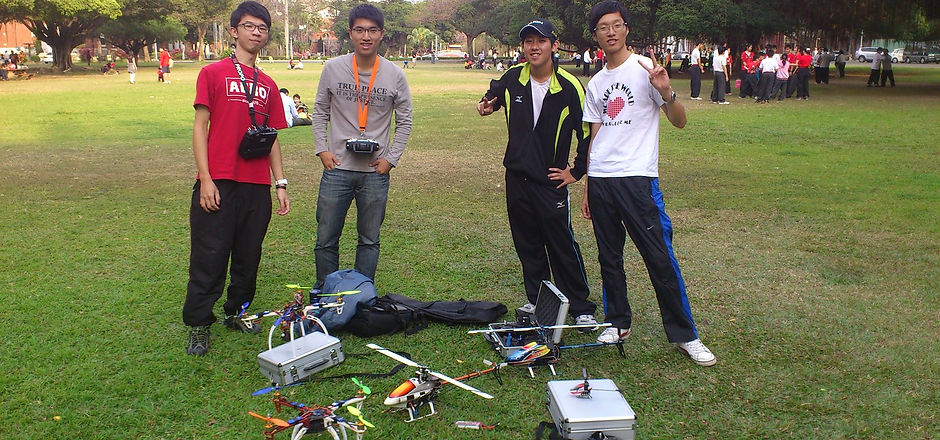
Hello There! I'm Che-Wei Ou.
Thanks for visiting! This is where you’ll find my professional experience and skills, my interests and education.
Professional Experience
Some special experience make me become the person you want to find!

Undergraduate Student Internship
July 1 - August 31, 2015
Jet Propulsion Laboratory, National Space Organization, Hsinchu,Taiwan
>> Researched a project called “Fluid analysis of solenoid valve” for Jet Propulsion Laboratory.
>> Built 3D model of solenoid valve for computational fluid dynamics by using CATIA.
>> Utilized Autodesk Simulation CFD to calculate the distribution of pressure, density, and velocity.
>> Made an experiment with Labview to certify the result of CFD.

Won second place in Taiwan Innovative Unmanned Aircraft Design Competition – Aircraft Design Level
September, 2013 - March, 2014
Pingtung, Taiwan
>> As a member of Remotely Piloted Vehicle Club (Sep. 2013-Jul. 2014), participated in this competition and won second place.
>> Made the composite material developing by R.P.V. club for making remote control aircraft.
>> Assembled the aircraft with other club members to join this competition.

Founded a Remote Control Club on campus
July 2014 - July 2015
National Cheng Kung University(NCKU), Tainan, Taiwan
>> Co-founded club on campus in July 2014 for every student in NCKU to utilize what they learn in class.
>> Lead over twenty members in club as a charter vice president to mange the organization.
>> Managed club resources and arranged the meetings for weekly activities.

Capstone Project on Aerospace Engineering - Making a 2.5 meter span RC aircraft
April 2016 - July 2017
National Cheng Kung University(NCKU), Tainan, Taiwan
>>Designed a remote control aircraft with a span of 2 meters.
>>Built a 3D model with CATIA V5 for laser cutting.
>>Made the composite material for making remote control aircraft.
>>Used the CFD software to simulate the aerodynamic properties of entire aircraft model.

Thesis: The effect of leading edge geometry on the induced drag of a finite wing
January 2018 - May 2019
This study identifies the influence that leading-edge shape has on the aerodynamic characteristics of a wing using surface far-field and near-field analysis. It examines if a wake survey is the appropriate means for measuring profile drag and induced drag. The paper unveils the differences between sharp leading-edge and blunt leading-edge wings with the tools of pressure loop, chordwise pressure distribution, span load plots and with wake integral computations. The analysis was performed using Computational Fluid Dynamics (CFD), vortex lattice potential flow code (VORLAX), and a few wind-tunnels runs to acquire data for comparison. This study found that sharp leading-edge wings have less leading-edge suction and higher drag than blunt leading-edge wings.
The blunt leading-edge wings have less drag because the normal vector of the surface in the front section of the airfoil develops forces at opposed skin friction. The shape of the leading edge, in conjunction with the effect of viscosity, slightly alter the span load; both the magnitude of the lift and the transverse distribution. Another goal in this study is to verify the veracity of wake survey theory; the two different leading-edge shapes reveals the shortcoming of Mclean’s equation which is only applicable to blunt leading-edge wings.
Ou, C. W. (2019). The Effect of Leading-Edge Geometry on the Induced Drag of a Finite Wing (Doctoral dissertation, Arizona State University).

When Higher Fidelity Models Degrade Our Understanding of Induced Drag - The Tragedy of the Trefftz Plane Integral
Jan 6, 2020
In this work, we show that common wake survey methods cannot differentiate between wings that do or do not develop substantial leading-edge-suction. We point the reader back to the classics and remind him that these derivations fundamentally neglect thickness. That theory is based on the idea that pressure forces always act orthogonal to the airfoil mean-line; thus, they only project normal forces into the drag direction. This means that follow-up theories developed from the Kutta-Joukowski theorem make the same assumption: that wings cannot develop axial forces due to inviscid flow mechanisms. Here, we show how an analytical leading-edge suction
correction found in old Vortex-Lattice-Method codes is both accurate and necessary to match test data. Hence, older codes such as VORLAX prove more useful to estimate inviscid drag than do newer wake-integral codes.

Aerodynamic Engineer in National Chung-Shan Institute of Science and Technology
Oct 2019 - Present
Working as a Wind Tunnel Testing Engineer.
Skills
Computer Skills
CATIA
AutoCAD
Ansys
Autodesk simulation CFD
Matlab
Labview
Arduino
MS office
Solidwork
PTC creo
Academic courses
Aerodynamic
Fluid mechanics
Linear algebra
Control system design
Electronic Circuits
Aircraft structure
Flight mechanics
Electricity & Magnetism
Numerical Methods and Applications
Thermodynamics
Learn more by clicking the link in Educational Experience page!
Management
Club management
Team communication
Language
Chinese - Mandarin (Native)
English
Education
Where I study
2017 - 2019
Master of Science – Aerospace engineering
Ira A. Fulton Schools of Engineering, Arizona State University, Tempe, Arizona, United States
⚫ Graduated with 3.92 GPA
⚫ Thesis: The effect of leading edge geometry on the induced drag of a finite wing
⚫ Coursework in CFD, FEA, and CAD
2013-2017
Bachelor of Science -
Aeronautics and Astronautics Engineering
Department of Aeronautics and Astronautics, National Cheng Kung Uiversity, Tainan, Taiwan
⚫ Graduated with 3.79 GPA
⚫ Awarded Outstanding Academic Achievement Prize
⚫ Graduated with Top 10% of Class
⚫ Coursework in Aircraft Design, Flight Control Design, Genetic Algorithms, etc.
If you have any other questions about my academic experience, don’t hesitate to contact me.
Contact Me
7F.-4, No.12, Ln. 175, Wuling Rd.
North Dist., Hsinchu City 30055 Taiwan (R.O.C.)
+886 908159036




